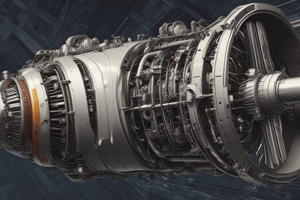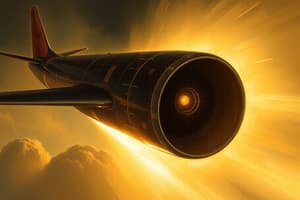Podcast
Questions and Answers
What is the formula for thrust in a turbofan engine?
What is the formula for thrust in a turbofan engine?
- Fn = Waf (V2 –V1) + Wac (V2 – V1) + Aj (Pj-Pam)/g (correct)
- Fn = Waf (V2 –V1) + Wac (V2 – V1)
- Fn = Waf (V2 –V1)
- Fn = Waf (V2 –V1) + Wac (V2 – V1) + Aj (Pj-Pam)
Which of the following individuals is NOT credited with pioneering early jet engine development?
Which of the following individuals is NOT credited with pioneering early jet engine development?
- Orville and Wilbur Wright
- Dr. A.A. Griffith
- Maxime Guillaume
- Thomas Edison (correct)
The speed of sound in air is affected by changes in both temperature and pressure.
The speed of sound in air is affected by changes in both temperature and pressure.
False (B)
The first applications of jet engines were primarily in commercial aircraft.
The first applications of jet engines were primarily in commercial aircraft.
What is the most efficient speed range for turboprop engines?
What is the most efficient speed range for turboprop engines?
Name two key materials that significantly impacted jet engine development, as mentioned in the text.
Name two key materials that significantly impacted jet engine development, as mentioned in the text.
The PW1100G turbofan engine has a bypass ratio of ______%.
The PW1100G turbofan engine has a bypass ratio of ______%.
Match the aircraft with its type of engine:
Match the aircraft with its type of engine:
The Concorde Olympus engine generated ____ times more thrust than Whittle's first engine, despite weighing ____ times more.
The Concorde Olympus engine generated ____ times more thrust than Whittle's first engine, despite weighing ____ times more.
What is the primary advantage of a high bypass turbofan engine?
What is the primary advantage of a high bypass turbofan engine?
The speed of sound in the rear stages of the compressor is slower than in the front stages due to the lower temperature.
The speed of sound in the rear stages of the compressor is slower than in the front stages due to the lower temperature.
What is the relationship between thrust and horsepower at 375 mph?
What is the relationship between thrust and horsepower at 375 mph?
What is the relationship between thrust and the change in momentum of the air mass passing through a jet engine?
What is the relationship between thrust and the change in momentum of the air mass passing through a jet engine?
The Concorde Olympus engine achieved ______ times more thrust than Whittle's first engine.
The Concorde Olympus engine achieved ______ times more thrust than Whittle's first engine.
Match the following jet engine manufacturers with their respective acronyms:
Match the following jet engine manufacturers with their respective acronyms:
Flashcards
Common Conversions
Common Conversions
Formulas to convert between aviation speed units.
Turbofan Thrust Equation
Turbofan Thrust Equation
Fn = Waf (V2 –V1) + Wac (V2 – V1) + Aj (Pj-Pam). Represents thrust calculation.
Turboprop Efficiency
Turboprop Efficiency
Turboprop engines perform best at 220-350 knots and 18,000-30,000 feet.
Thrust to Horsepower Ratio
Thrust to Horsepower Ratio
Signup and view all the flashcards
Back and Front Flow
Back and Front Flow
Signup and view all the flashcards
Temperature Effects on Sound Speed
Temperature Effects on Sound Speed
Signup and view all the flashcards
High Bypass Turbofan
High Bypass Turbofan
Signup and view all the flashcards
PW1100G Turbofan
PW1100G Turbofan
Signup and view all the flashcards
Newton's Third Law of Motion
Newton's Third Law of Motion
Signup and view all the flashcards
Thrust Equation
Thrust Equation
Signup and view all the flashcards
Propulsive Efficiency
Propulsive Efficiency
Signup and view all the flashcards
V2 vs V1
V2 vs V1
Signup and view all the flashcards
Choked Nozzle
Choked Nozzle
Signup and view all the flashcards
Gross Thrust
Gross Thrust
Signup and view all the flashcards
Net Thrust
Net Thrust
Signup and view all the flashcards
Mass in Thrust
Mass in Thrust
Signup and view all the flashcards
Study Notes
Jet Propulsion Theory
- Newton's Third Law of Motion: For every action, there is an equal and opposite reaction.
- Newton's Second Law of Motion: Thrust = Mass x Acceleration, or Thrust = Mass x change in Velocity, or Thrust = Mass x change in momentum.
Newton's First Law Applied to Airplanes
- An object in motion stays in motion unless acted upon by an outside force.
- Thrust and Drag: When Thrust equals Drag, airspeed is constant. Increasing Thrust increases airspeed, and Drag increases with airspeed. When Drag equals Thrust again, the aircraft no longer accelerates but holds a new, higher constant airspeed.
Pioneers and Early Development
- Key factors for jet engine efficiency improvements: pressure rise by the compressor, temperature of the gases entering the turbine and combustor efficiency.
- Early applications were military aircraft, primarily emphasizing speed.
- Key figures: Orville and Wilbur Wright, Maxime Guillaume, Dr. A. A. Griffith, Hans von Ohain, Frank Whittle, and Dr. Hanratty.
Aircraft Types and Manufacturers
- Aircraft examples: Gloster, Meteor, Me-262, Bell XP-59A, Tornado B-45, Canberra, B-707, DC-8.
- Engine manufacturers: CFM, PW, RR, GE, and International Aero.
The Concord Olympus Engine
- The Concorde Olympus engine: weighed seven times more than Whittle's first engine but achieved 25 times more thrust at three times the speed with a lower specific fuel consumption.
Propulsive Efficiency
- Propulsive efficiency varies with airspeed and engine type (turbojet, turboprop, high-bypass turbofan, low bypass turbofan).
Force and Momentum
- Force (F) = Thrust, Weight of air & fuel divided by gravity (M).
- Acceleration (a) = change in momentum of mass.
- In metrics, 4.45 Newtons = 1 lb.
Acceleration Calculation
- Acceleration = change in momentum.
- Velocity of the air exiting the engine (V₂ or V jet).
- Velocity of the air entering the engine (V₁ or V flight).
- Change in velocity (V₂ - V₁)
Gross vs. Net Thrust
- Gross thrust: total thrust generated by the engine.
- Net thrust: thrust available with forward engine speed.
Choked Nozzles
- A choked nozzle accelerates exhaust gases to the local speed of sound; no more, no less.
Atmospheric Pressure at Altitude
- A table of pressure (psi) at different altitudes (ft) is provided.
Common Conversions
- Conversion factors for knots, mph, feet per second, PSI, and inHg.
Turbofan Engine
- Calculation of thrust (Fn):
Fn = Waf (V2 – V1) / g + Wac (V2 – V1) / g + Aj (Pj-Pam)
Turboprop Engine
- Engine rated in shaft horsepower(SHP) using dynamometer.
- Calculation of thrust (Fn) only applicable during flight, straight and level flight.
- The engine design combines turbojet and propeller characteristics, efficient at speeds between 220 and 350 knots and altitudes between 18,000 and 30,000 feet.
- At 375 mph, one pound of thrust equals one horsepower.
Specific Aircraft Examples
- Navy P-3 Orion: describes its flow direction.
- King Air 200: Specifications such as take-off weight, engine type, power (850 SHP), speed (260 KIAS), and torque (1369 ft-lbs) are mentioned, along with altitude(FL260), and prop efficiency(80%).
Practice Problems
- Problems on various calculations involving thrust, horsepower, altitude, and speed related to different aircraft types (e.g., turboprop, turbo-jet, turbofan engines) are noted.
Engine Comparison
- Comparison of CFM LEAP-1A and PW1100G engine parameters, including thrust, bypass ratio, architecture, and dimensions.
Geared Turbo Fan (GTF)
- Advanced high-pressure turbine (HPT) and 8-stage high-speed low-pressure compressor (LPC).
Studying That Suits You
Use AI to generate personalized quizzes and flashcards to suit your learning preferences.




